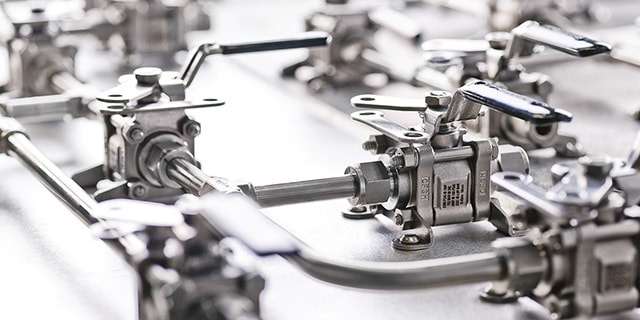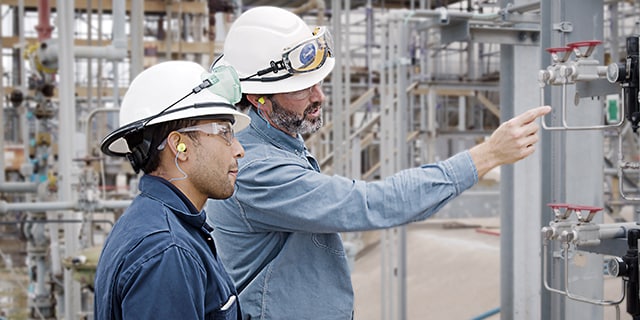8 Common Process Analyzer Accuracy Challenges

Sampling Systems: 8 Common Process Analyzer Accuracy Challenges
Tony Waters, Sampling Systems Expert and Instructor
Sampling systems are among the most complex systems in a plant. They feature numerous components and processes that must work together to produce an analytical reading of process stream conditions. That reading must be both accurate and timely, as this important result will be used to achieve a plant’s control objectives. Yet, a plant’s engineers and technicians know that a sampling system can be finicky. Every element of the system has the potential to impact the process analyzer accuracy. To help your team improve system analyzer reliability, Swagelok field engineers have identified eight common challenges impacting a system’s accuracy.
Impact to Analyzer Accuracy
Design missteps in sampling systems can threaten sample integrity by impacting the following:
- Representativeness: Design flaws can lead to the sample not accurately representing the process and even distorting the chemical composition of the process fluid in an unpredicted or unintended way. The system requires a representative sample to ensure the measurement meets control objectives.
- Timeliness: If an excessive time delay occurs between capturing a sample and obtaining an analyzer reading, a plant may risk lost product or costly reprocessing to correct a production error. A standard industry response time is one minute.
- Compatibility: If temperature, pressure, flow, and/or state don’t match the requirements of the process analyzer, the sample may harm the system analyzer or compromise its accuracy. In addition, accurate analyzer results help maintain a safe plant environment by flagging potentially dangerous operating conditions.
Identifying & Addressing Common Challenges
Challenge 1: Improper Tap Locations
Choosing a tap location can be a nuanced decision. One goal is to avoid time delay. If the tap is on a low-flow section of the process pipe, it will take longer for any change in the process chemicals to show up in an analytical result. Mixing volumes, such as a tower bottom, tank or drum, are also a large source of delay. In addition, system designers should choose a location where the sample will be well blended, such as downstream of induced turbulence from a pump discharge, flow orifice, or piping elbow.
Challenge 2: Probe Misuse
When using a probe to capture a sample, it should ideally be long enough to reach the middle third of the process pipe, so you are pulling a representative sample. You will also get a timelier result near the center of the process pipe because the flow is faster there. However, you should always calculate the maximum allowable length to ensure your probe will not suffer resonant vibration. Sometimes it’s sufficient to get only 15 % insertion into the pipe diameter. The probe should not be any wider than necessary because large volumes lead to time delay. If using a nozzle only, without a probe, the system will probably have a much larger volume, leading to significant delay.
Challenge 3: Incorrect Field Station Designs
With a gas sample, system designers will want to reduce the pressure as soon as possible (to 10-15 psig, or even 5 psig if your system design will allow it). High-pressure gases move more slowly because the molecules are packed tightly, leading to time delay. Also, low pressure reduces the risk of condensation, which is something you want to avoid because it is not compatible with many gas process analyzers and compromises the representativeness of the sample. Another reason for maintaining low pressure is safety for the operators and technicians.
A regulator at the field station reduces pressure in the sample, enabling it to flow more quickly to the analyzer.
Challenge 4: Skipping a Fast Loop
When vaporizing a liquid sample, your sampling system may need a fast loop or bypass upstream from the vaporizing regulator. Otherwise, the liquid sample may flow too slowly, leading to time delay because a small volume of liquid will yield a large volume of gas. Without a fast loop, there may be over 100 mL of slow-moving liquid volume upstream of the regulator, which could lead to many hours of time delay.
Challenge 5: Deadlegs
Deadlegs compromise the representativeness of a sample by storing old sample molecules and slowly bleeding them into the new sample. Any tee or cross in the sample line is a deadleg, unless all its ports are flowing. Some examples include gauges or switches, pressure relief valves, or lab sample points. Deadlegs are more likely to compromise an analytical result when you are switching to a low-concentration stream from a high-concentration stream. Deadlegs are also more likely to be a problem at low flow. Deadlegs in a direct line to the analyzer should be moved or removed.
Challenge 6: Cross-Stream Contamination
A single three-way valve is not a sufficient barrier between calibration fluid and the sample. With this arrangement, the calibration fluid may leak across the valve seat and contaminate the sample – or, more likely, the process stream sample might leak into the calibration fluid. Either scenario will spoil the analysis. A better configuration is a double-block-and-bleed setup, which ensures that any leakage from any blocked port will go to a bleed or vent line and not into the sample.
Challenge 7: Improper Temperature and Pressure
Beware of phase changes in your samples, as you want to prevent a partial phase change. Mixed-phased samples are not representative and are probably not compatible with your system analyzer. It’s not difficult to determine whether your sample is changing phases. A software program can produce a phase diagram for your system’s chemical composition. As a rule, you want to keep gas samples above the dew point (so they do not condense) and liquid samples below their bubble point (so lighter components do not boil off). If you are heating your line, you must heat all of it because even a few inches of unheated line are enough to lower the temperature and cause condensation. Aim to keep gases about 20°C above the dew point.
Challenge 8: Improper Sample Conditioning
In a sampling condition system, you want to remove liquids from a gas sample because they may harm your system process analyzer and compromise your analytical result. You can remove large droplets in a gas sample with gravity (via a knockout pot or fallback tube) or inertia (via a kinetic separator or cyclone). But very fine droplets suspended as an aerosol require a coalescer. However, it’s important to understand that coalescers will not filter out large droplets. Further, if the flow rate is too high, smaller droplets will get pushed through the coalescer’s elements and will not drip out as they should. Finally, as your sample leaves the coalescer, it will be saturated – near the dew point and close to condensing again. It’s helpful to get away from the dew point by raising the temperature or dropping the pressure. You can create a pressure drop with a needle valve.
For more information about identifying and addressing threats to process analyzer accuracy in sampling systems, explore Swagelok’s sampling system hands-on training courses or contact your local Swagelok sales and service center for a copy of Industrial Sampling Systems, the textbook on which Swagelok’s training courses are based.
Related Articles

How to Isolate Industrial Fluid Systems with Block Valves
The isolation of industrial fluid system lines prior to maintenance is vital to plant safety. One of the safest ways to isolate a fluid system line is to install two block valves. Learn how to design proper configurations for your system.

10 Tips to Improve Sampling Systems
Managing an analytical instrumentation operation is no small feat. Receiving consistent results can be a struggle for even the most seasoned engineers. Luckily, there are several simple tips your team can use to improve your sampling system.

7 Tips for Building Safer Industrial Fluid Systems
When designing industrial fluid systems, plant safety must always remain top of mind. Learn how your team of engineers and technicians can reduce safety risks and maintain system uptime with essential fluid system building and design tips.

